List of World Heritage Sites in China
The United Nations Educational, Scientific and Cultural Organization (UNESCO) World Heritage Sites are places of importance to cultural or natural heritage as described in the UNESCO World Heritage Convention, established in 1972.[1] Cultural heritage consists of monuments (such as architectural works, monumental sculptures, or inscriptions), groups of buildings, and sites (including archaeological sites). Natural features (consisting of physical and biological formations), geological and physiographical formations (including habitats of threatened species of animals and plants), and natural sites which are important from the point of view of science, conservation or natural beauty, are defined as natural heritage.[2] China accepted the convention on 12 December 1985, making its sites eligible for inclusion on the list.[3]
China has 59 World Heritage Sites on the list, ranking second in the world, just below Italy with 60 sites.[4] Of these 59 sites, 40 are listed for their cultural, 15 for their natural, and four sites for both cultural and natural significance. I addition, China also has 59 sites on its tentative list.[3]
The first sites in China were added to the list in 1987 when six sites were inscribed. The most recent addition took place in 2024, when the Beijing Central Axis was listed. One site is transnational, the Silk Roads: the Routes Network of Chang'an-Tianshan Corridor is shared with Kazahkstan and Kyrgizstan.[3]
World Heritage Sites
[edit]UNESCO lists sites under ten criteria; each entry must meet at least one of the criteria. Criteria i through vi are cultural, and vii through x are natural.[5]
| Site | Image | Location (province) | Year listed | UNESCO data | Description |
|---|---|---|---|---|---|
| Mount Taishan | 
|
Shandong | 1987 | 437; i, ii, iii, iv, v, vi, vii (mixed) | Mount Tai is the most important of the five Sacred Mountains of China. It is a giant rock mass covered with dense vegetation, towering over a surrounding plateau. Its natural beauty has inspired people for millennia. It was a site of the imperial cult for over 2,000 years, with emperors themselves performing Feng Shan sacrifices. There are numerous temples, stelae, and stone inscriptions on the mountain slopes, both Buddhist and Taoist. The mountain is connected with a series of historical events of China, including the emergence of Confucianism, the unification of the country under the Qin dynasty, and the emergence of writing and literature.[6] |
| The Great Wall | 
|
Beijing, Hebei, Gansu | 1987 | 438; i, ii, iii, iv, vi (cultural) | The Great Wall is a series of fortifications in northern China with a total length of over 20,000 km (12,000 mi). Construction of the Wall, intended as a defense against the invaders from the north, begun in the 3rd century BCE under the Emperor Qin Shi Huang who connected earlier existing sections. Work on the Great Wall continued until the 17th century under the Ming dynasty. The Wall comprises fortresses, watchtowers, passes, and shelters along the way. It has featured prominently in literature for centuries. Three sections of the wall are listed, the terminuses at Jiayuguan City and Shanhai Pass, and the Badaling section (pictured) near Beijing.[7] |
| Imperial Palaces of the Ming and Qing Dynasties in Beijing and Shenyang | 
|
Beijing, Liaoning | 1987 | 439bis; i, ii, iii, iv (cultural) | The Forbidden City in Beijing (the Hall of Supreme Harmony pictured) was the seat of the Ming and Qing dynasties from 1416 to 1911. The palaces in Beijing and Shenyang, where the Mukden Palace was added to the site in 2004, represent the development of palatial architecture in China and the fusion of Han, Manchu, Mongolian, and Tibetan cultures and influences, especially in the 17th and 18th centuries. The palace complexes are filled with works of art and also demonstrate the traditions of shamanism practiced by the Manchu.[8] |
| Mogao Caves | 
|
Gansu | 1987 | 440; i, ii, iii, iv, v, vi (cultural) | The caves in the Dunhuang oasis contain an outstanding collection of Buddhist art spanning from the 4th to 14th centuries. They reflect cultural exchanges between China, India, and Central Asia, as well as the art of various ethnic minorities of China. They also provide insight into the life and culture of the Sui, Tang, and Song dynasties. In the 19th century, the caves were occupied by Buddhist monks while they drew the attention of archeologists and were protected after 1930. One of the most prominent finds were the Dunhuang manuscripts which were discovered in one of the caves in 1900.[9] |
| Mausoleum of the First Qin Emperor | 
|
Shaanxi | 1987 | 441; i, iii, iv, vi (cultural) | The mausoleum was constructed for Qin Shi Huang of the Qin dynasty, the first Emperor of China and unifier of the country, who died in 210 BCE. The massive mausoleum comprises the grave mound with a height above 50 m (160 ft) and numerous accompanying pits with funerary objects. Of these, the most famous is the Terracotta Army (pictured), thousands of life-sized and realistic terracotta statues of warriors, as well as horses and chariots. The site was discovered in 1974.[10] |
| Peking Man Site at Zhoukoudian | 
|
Beijing | 1987 | 449; iii, vi (cultural) | Zhoukoudian (entrance pictured) is an archaeological site with limestone caves that preserved remains of ancient humans, tools, and animals from the Pleistocene. Excavations have been going on since the early 20th century. The finds include the so-called Peking Man, a subspecies of Homo erectus who lived 700,000 to 200,000 years ago, archaic Homo sapiens from about 200,000 to 100,000 years ago, and modern humans dating back to 30,000 years ago. They provide an important insight into the human evolution and the life of human communities in Asia.[11] |
| Mount Huangshan | 
|
Anhui | 1990 | 547bis; ii, vii, x (mixed) | Huangshan, or Yellow Mountain, is a granite mountain range with numerous peaks, boulders, caves, waterfalls, and rock formations. It has ancient pine trees and is home to a rich assemblies of bryophytes and ferns. There are several endemic plant species. The scenic landscape of the mountain has been inspiring the Chinese imagination since at least the time of the Tang dynasty of the 8th century. It has featured in poems and paintings and has a school of painting named after it. A minor boundary modification of the site took place in 2012.[12] |
| Jiuzhaigou Valley Scenic and Historic Interest Area | 
|
Sichuan | 1992 | 637; vii (natural) | The valley is surrounded by jagged mountain peaks reaching up to 4,800 m (15,700 ft) high. There are numerous karst features, including caves, limestone terraces, as well as pools and waterfalls, resulting in a scenic beauty. The valley has a series of diverse forest ecosystems that are home to some 140 bird species, the giant panda, and Sichuan takin.[13] |
| Huanglong Scenic and Historic Interest Area | 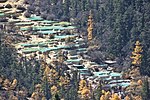
|
Sichuan | 1992 | 638; vii (natural) | The mountain landscape has glaciers, diverse forest ecosystems, waterfalls, and karst formations. A special feature is a series of travertine terraces and lakes (pictured). The area is home to the giant panda and golden snub-nosed monkey.[14] |
| Wulingyuan Scenic and Historic Interest Area | 
|
Hunan | 1992 | 640; vii (natural) | The defining feature of the landscape is the collection of more than 3,000 quartz sandstone pillars and peaks, some of which are more than 200 m (660 ft) tall. Other interesting landforms include karst caves with calcite deposits, gorges, ravines, pools, waterfalls, and two large natural stone bridges. The area is home to the Asian black bear, dhole, and water deer.[15] |
| Mountain Resort and its Outlying Temples, Chengde | 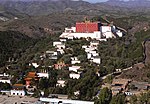
|
Hebei | 1994 | 703; ii, iv (cultural) | The resort was built in the 18th century as the summer palace for the Qing dynasty emperors. At the same time it functioned as a base to strengthen administration in the border regions. The palaces, temples, and gardens are designed to be integrated harmoniously with the natural environment, following the principles of feng shui. Several temples are in the styles of ethnic minorities of the empire. The Putuo Zongcheng Temple in the Tibetan style is pictured.[16] |
| Temple and Cemetery of Confucius and the Kong Family Mansion in Qufu | 
|
Shandong | 1994 | 704; i, iv, vi (cultural) | Qufu was the birthplace of Confucius, the great Chinese philosopher, educator, and politician, who died in the 5th century BCE. His teachings, known as Confucianism, were greatly influential in China, Korea, Japan, Vietnam, as well as in the 18th century Europe during the Age of Enlightenment. The temple was originally built in 478 BCE and was rebuilt and expanded over centuries. The continuous support of the emperors meant that the finest artisans worked on the complex which includes the Temple of Confucius (pictured), the Kong Family Mansion, and the Cemetery of Confucius where he and more than 100,000 of his descendants are buried.[17] |
| Ancient Building Complex in the Wudang Mountains | 
|
Hubei | 1994 | 705; i, ii, vi (cultural) | The religious complex in the Wudang Mountains was established as a centre for Taoism under the Tang dynasty in the 7th century. It reached its peak under the Ming dynasty between the 14th and 17th centuries. Today, the complex preserves 53 palaces, temples, and shrines in nine different architectural style, including those from the Yuan and Qing dynasties. The buildings represent the highest architectural and artistic standards of China through centuries and were influential in the development of public and religious architecture in the country. The Purple Cloud Temple is pictured.[18] |
| Historic Ensemble of the Potala Palace, Lhasa | 
|
Tibet | 1994 | 707ter; i, iv, vi (cultural) | The palace (pictured) in Lhasa served as the winter residence of the Dalai Lamas from the 7th century. It represents the role that Tibetan Buddhism had in the administration and governance of the Tibetan society. The vast palace is filled with works of art, including murals, painted scrolls, sculptures, and porcelain, and has a collection of important historic documents. In 2000 and 2001, respectively, the site was expanded to include the Jokhang temple monastery from the 7th century and Norbulingka, the summer residence of the Dalai Lamas from the 18th century.[19] |
| Lushan National Park | 
|
Jiangxi | 1996 | 778; ii, iii, iv, vi (cultural) | The cultural landscape around Mount Lu and Poyang Lake has been inspiring philosophers and artists for more than two millennia and was the cultural centre of southern China. There are more than 200 historic buildings in the national park, including Buddhist and Taoist temples and sites of Confucianist teachings, in particular the White Deer Grotto Academy. The stone arch Guanyin Bridge from the Song dynasty is important in history of Chinese civil engineering.[20] |
| Mount Emei Scenic Area, including Leshan Giant Buddha Scenic Area | 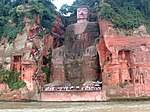
|
Sichuan | 1996 | 779; iv, vi, x (mixed) | Mount Emei is one of the four sacred Buddhist mountains in China. It is the site of the first Buddhist temple in China, constructed when the religion was introduced from India via the Silk Road in the 1st century CE. Today, there are over 30 temples from different periods on the mountain, as well as several important monuments. The best known is the Leshan Giant Buddha (pictured), a 71 m (233 ft) tall statue carved in stone in the 8th century. The mountain is also important for its animal and plant biodiversity, with forest types spanning from subtropical evergreen broad-leaved forest at the bottom to subalpine conifer forest at the highest elevations.[21] |
| Old Town of Lijiang | 
|
Yunnan | 1997 | 811bis; ii, iv, v (cultural) | Located on the meeting point between the Silk Road and the ancient Tea Horse Road, Lijiang was an important trade centre between Sichuan, Yunnan, and Tibet from the 12th century onward. It was a meeting point of Han, Nakhi, Bai, and Tibetan people and other communities, which is reflected in a particular local architecture, urban planning, and traditions. The city also demonstrates a harmonious coexistence of Confucianism, Taoism, and Buddhism. A prominent feature of the city is its traditional water supply system, with waters from the mountains being collected in the Black Dragon Pool and are then distributed through a series of canals and channels. A minor boundary modification of the site took place in 2012.[22] |
| Ancient City of Ping Yao | 
|
Shanxi | 1997 | 812; ii, iii, iv (cultural) | The city of Pingyao was founded under the Ming dynasty in the 14th century. The city centre (market tower pictured) is a well-preserved example of a Han Chinese traditional city and it demonstrates the evolution of architectural styles under the Ming and Qing dynasties. In the 19th and early 20th centuries, it was the major banking centre of the country. In addition to the old city centre, two temples are listed as well, the Zhenguo Temple and the Shuanglin Temple. Both are important due of their architecture and art collections.[23] |
| Classical Gardens of Suzhou | 
|
Jiangsu | 1997 | 813bis i, ii, iii, iv, v (cultural) | The design of Chinese gardens has been developing for more than two millennia. The gardens in the city of Suzhou demonstrate some of the finest examples of the form, including water features, rock formations, pavilions, bridges, and meticulously arranged plants, designed to create harmonious and miniature landscapes that reflect the natural world. Out of more than 50 such gardens in the city, four were listed in 1997, and a further five were added in 2000. They date between the 11th and 19th centuries. The Humble Administrator's Garden is pictured.[24] |
| Summer Palace, an Imperial Garden in Beijing | 
|
Beijing | 1998 | 880; i, ii, iii (cultural) | The palace was conceived next to the Kunming Lake in Beijing in the mid-18th century under the Qing Qianlong Emperor. It is a prominent example of a Chinese garden, with water features, pavilions, temples, and bridges. It had an important influence on subsequent garden designs. It was destroyed during the Second Opium War in 1860, restored in 1888, again damaged in during the Boxer Rebellion in 1900, restored, and has been a public park since 1924.[25] |
| Temple of Heaven: an Imperial Sacrificial Altar in Beijing | 
|
Beijing | 1998 | 881; i, ii, iii (cultural) | The Temple of Heaven in Beijing is the most representative of the sacrificial buildings in China. Its design and symbolic layout had an important influence on subsequent buildings. The original temple was constructed in 1420 under the Ming dynasty, together with the Forbidden City. The current layout dates to 1749, following a renovation under the Qing dynasty. The Hall of Prayer for Good Harvests, where the emperors offered sacrifice to Heaven for abundant harvests, is pictured.[26] |
| Mount Wuyi | 
|
Fujian | 1999 | 911bis; ii, vi, vii, x (mixed) | The area of Mount Wuyi preserves the largest largely intact examples of subtropical and rainforests in China. The forests are rich in biodiversity and home to several relict species. Along the Nine Bend River (pictured), there are high cliffs and sandstone rock formations. There is an archaeological site of a Han dynasty administrative capital from the 1st century BCE. There are also several temples and Confucianist learning centres that were associated with the development of the Neo-Confucianist philosophy in the 11th century. A minor boundary modification of the site took place in 2017.[27] |
| Dazu Rock Carvings | 
|
Chongqing | 1999 | 912: i, ii, iii (cultural) | This site comprises five clusters with rock reliefs near the city of Chongqing. They date from the 9th to the 13th centuries and depict Confucianist, Taoist, and Buddhist motifs, side by side. This demonstrates the harmonious coexistence of these three religions in China. There are also secular motifs. The carvings represent the pinnacle of Chinese rock art. The group at Mount Baoding is pictured.[28] |
| Ancient Villages in Southern Anhui – Xidi and Hongcun | 
|
Anhui | 2000 | 1002; iii, iv, v (cultural) | These two villages (Hongcun pictured) represent typical villages of Anhui as they were between the 14th and 20th centuries, a type of settlement that has by now largely disappeared. The villages were developed by successful officials or merchants returning home after assignments. The layout and the buildings reflect the social structure of feudal China and its values based on Confucianism and Neo-Confucianism.[29] |
| Imperial Tombs of the Ming and Qing Dynasties, including the Ming tombs and the Ming Xiaoling Mausoleum * |   
|
Beijing, Liaoning, Jiangsu | 2000, 2003, 2004 | i, ii, iii, iv, vi | The Ming tombs, are a collection of imperial mausoleums where 13 emperors of the Ming Dynasty (1368–1644) are buried. The Ming Xiaoling Mausoleum, is the burial site of the first Ming emperor, Zhu Yuanzhang, and his empress. This site is characterized by its path lined with stone statues, which leads to the main burial mound. The design and layout of the tombs are planned to symbolize the unity and dignity of the emperor's rule, incorporating architectural elements and geomantic principles to ensure peace and harmony in the afterlife.1004 |
| Longmen Grottoes * | 
|
Henan | 2000 | i, ii, iii | A collection of Buddhist cave temples carved into the limestone cliffs of the Xiangshan and Longmenshan mountains. Dating from the late Northern Wei to the Tang Dynasty (5th to 10th centuries), these grottoes contain tens of thousands of statues of Buddha and his disciples, ranging in size from a few centimeters to several meters tall. The site is renowned for its impressive array of Buddhist art, which includes intricately carved statues, inscriptions, and reliefs. The Longmen Grottoes reflect the high point of Chinese stone carving, and the Fengxian Temple, with its colossal statue of Vairocana Buddha, is among the most celebrated of these carvings.1003 |
| Mount Qingcheng and the Dujiangyan Irrigation System * | 
|
Sichuan | 2000 | ii, iv, vi | Mount Qingcheng is one of the birthplaces of Taoism, China's indigenous religion, and is dotted with ancient Taoist temples amid its lush forested landscape, offering a serene and spiritual experience.
The Dujiangyan Irrigation System, constructed in the 3rd century BCE, is an ancient technological marvel still in use today. It was ingeniously designed to control flooding and irrigate farmland along the Minjiang River by dividing the river into channels. This system transformed the Sichuan basin into one of China's most fertile regions without the need for a dam, showcasing early Chinese engineering skills.1001 |
| Yungang Grottoes * | 
|
Shanxi | 2001 | i, ii, iii, iv | A series of ancient Buddhist temple grottoes dating back to the 5th and 6th centuries. These grottoes are carved into the side of a sandstone cliff and contain thousands of statues and intricate murals that represent some of the outstanding examples of early Chinese Buddhist art. Comprising 252 caves and over 51,000 Buddha statues, the Yungang Grottoes showcase a variety of artistic styles and influences, reflecting the cultural exchange between China and other regions along the Silk Road. The site is notable for its large-scale statues, which exhibit a blend of Indian and Chinese art styles.1039 |
| Three Parallel Rivers of Yunnan Protected Areas † | 
|
Yunnan | 2003 | vii, viii, ix, x | Where the Yangtze, Mekong, and Salween rivers run roughly parallel to each other through deep gorges and mountainous terrain. This area is noted for its exceptional biodiversity and significant topographical diversity, ranging from snow-capped peaks to tropical rainforests, hosting a wide array of flora and fauna, including many endemic and endangered species.1083 |
| Capital Cities and Tombs of the Ancient Koguryo Kingdom * | 
|
Jilin | 2004 | i, ii, iii, iv, v | The site represent the archaeological remnants of the Koguryo Kingdom, one of the Three Kingdoms of Korea, which existed from the 1st century BC to the 7th century AD. The Site encompasses two main components: the capital cities of Wunu Mountain City, Guonei City, and Wandu Mountain City, along with a series of royal tombs found in the region. The capital cities illustrate the urban planning and defensive architectures typical of the Koguryo Kingdom, showcasing the sophistication and strategic ingenuity of Koguryo urban design and military fortifications. The tombs are famous for their wall paintings, which depict daily life scenes, mythical figures, and the spiritual beliefs of the Koguryo people.1135 |
| Historic Centre of Macau * | 
|
Macau | 2005 | ii, iii, iv, vi | A collection of over twenty locations that testify to the successful fusion of Chinese and Portuguese cultures in Macau. The Historic Centre includes a range of buildings and public spaces that illustrate the integration of architectural, technological, and artistic influences from both East and West. Notable landmarks within the Historic Centre include the Ruins of St. Paul's, the Senado Square, A-Ma Temple, and the Guia Fortres. |
| Yinxu * | 
|
Henan | 2006 | ii, iii, iv, vi | The archaeological site of the ancient capital of the late Shang Dynasty, dating from the 14th to the 11th centuries BCE. Yinxu is known for its collection of artifacts, including oracle bones, bronze ware, and royal tombs. The site also includes the remains of large palatial structures and royal tombs.1114 |
| Sichuan Giant Panda Sanctuaries † | 
|
Sichuan | 2006 | x | Approximately 9,000 square kilometers of forested and mountainous terrain. Home to more than 30% of the world's endangered giant pandas.
The sanctuaries include several national parks and reserves such as Wolong, Mt. Siguniang, and Jiajin Mountains. These areas provide a refugefor the giant pandaand other endangered species such as the red panda, the snow leopard, and the clouded leopard. 1213 |
| Kaiping Diaolou and Villages * | 
|
Guangdong | 2007 | ii, iii, iv | The site consists of several fortified multi-story towers, known as "diaolou," and traditional villages. The diaolou served both as residential houses and as protective fortresses against banditry and local wars. They are characterized by their Roman, Baroque, and even Gothic elements alongside traditional Chinese designs. 1112 |
| South China Karst † | 
|
Yunnan, Guizhou, Chongqing and Guangxi | 2007, 2014 | vii, viii | The area is divided into three: the Libo Karst, Shilin Karst, and Wulong Karst. Each of these areas showcases different karst formations that have evolved over millions of years. For instance, the Shilin Karst is known for its stone forests, while the Wulong Karst features natural bridges and giant dolines (sinkholes).1248 |
| Fujian Tulou * | 
|
Fujian | 2008 | iii, iv, v | Constructed between the 12th and 20th centuries, these buildings are recognized for their circular or rectangular shapes. Designed to house up to 800 people, each Tulou functions as a self-contained community, featuring thick earth walls that provide security and moderate internal temperatures. The architectural layout includes a central courtyard surrounded by multi-story living quarters.1113 |
| Sanqingshan † | 
|
Jiangxi | 2008 | vii | Characterized by its pillars and peaks. The area spans 2,300 hectares and is known for its three main peaks, which are said to represent the three supreme gods in Taoism. Sanqingshan is home to many ancient temples, some of which are hidden in its many caves and crevices.1292 |
| Mount Wutai * | 
|
Shanxi | 2009 | ii, iii, iv, vi | The mountain is recognized as one of the Four Sacred Buddhist Mountains of China. The name "Wutai" means "Five Terraces," reflecting the mountain's five flat peaks, which are said to symbolize the five elements of earth, water, fire, wind, and void.
Mount Wutai is home to temples, 53 monasteries, and numerous other religious structures.1279 |
| Historic Monuments of Dengfeng in "The Centre of Heaven and Earth" * | 
|
Henan | 2010 | iii, vi | Known as "The Centre of Heaven and Earth". The ensemble includes various temples, pagodas, and academies dating back as far as the Han Dynasty. Among these, the Shaolin Temple, often credited as the birthplace of Zen Buddhism and Shaolin martial arts. Other notable components include the Songyue Pagoda, one of the oldest brick pagodas in China, and the Observatory of Dengfeng.1305 |
| China Danxia † | 
|
Hunan, Guangdong, Fujian, Jiangxi, Zhejiang, and Guizhou | 2010 | vii, viii | China Danxia is a type of karst landform characterized by red sandstone cliffs and a range of erosional landscapes, including natural pillars, towers, ravines, valleys, and waterfalls. Danxia formations are spread across several regions in southeastern and southwestern China, including areas in Guangdong, Fujian, Jiangxi, Hunan, and Zhejiang provinces.1335 |
| West Lake Cultural Landscape of Hangzhou * | 
|
Zhejiang | 2011 | ii, iii, vi | characterized by its lake, surrounding hills, gardens, and historic sites. Located in the city of Hangzhou, Zhejiang Province, West Lake is surrounded by numerous temples, pagodas, pavilions, and gardens.1334 |
| Site of Xanadu * | 
|
Inner Mongolia | 2012 | ii, iii, iv, vi | An archaeological site that was once the summer capital of Kublai Khan's Yuan Dynasty. This site encompasses the ruins of the imperial city of Xanadu. The remains include palace foundations, city walls, and other structures that offer insight into the layout and architecture of the ancient city.
Xanadu is notable for its strategic location along the Silk Road and its role as a political and cultural center during the Yuan Dynasty. It served as a symbol of imperial power and a hub for trade and cultural exchange between East and West. 1389 |
| Chengjiang Fossil Site † | 
|
Yunnan | 2012 | viii | Archaeological site renowned for its preserved fossils dating back to the Cambrian period. The fossils found here include a wide variety of preserved organisms, such as trilobites, sponges, algae, and the iconic Chengjiang Biota, which comprises numerous soft-bodied organisms rarely preserved in the fossil record.1388 |
| Xinjiang Tianshan † | 
|
Xinjiang | 2013 | vii, ix | 1414 |
| Cultural Landscape of Honghe Hani Rice Terraces * | 
|
Yunnan | 2013 | iii, v | 1111 |
| Silk Roads: the Routes Network of Chang'an-Tianshan Corridor * | 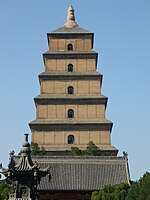
|
Henan, Shaanxi, Gansu and Xinjiang | 2014 | ii, iii, v, vi | 1442 |
| Grand Canal * | 
|
Beijing, Tianjin, Hebei, Shandong, Jiangsu, Zhejiang, Anhui and Henan | 2014 | i, iii, iv, vi | 1443 |
| Tusi Sites * | 
|
Hunan, Hubei and Guizhou | 2015 | ii, iii | 1474 |
| Zuojiang Huashan Rock Art Cultural Landscape * | 
|
Guangxi | 2016 | iii, vi | 1508 |
| Hubei Shennongjia † | 
|
Hubei | 2016 | ix, x | 1509 |
| Qinghai Hoh Xil † | 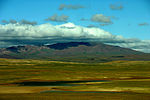
|
Qinghai | 2017 | vii, x | 1540 |
| Kulangsu: a Historic International Settlement * | 
|
Fujian | 2017 | ii, vi | 1541 |
| Fanjingshan † | 
|
Guizhou | 2018 | x | 1559 |
| Archaeological Ruins of Liangzhu City * | 
|
Zhejiang | 2019 | iii, iv | The archaeological ruins of an ancient city during about 3,300-2,300 BCE, which exemplifies an early regional state with a unified belief system based on rice cultivation in the Yangtze River Basin of Late Neolithic China.1592 |
| Migratory Bird Sanctuaries along the Coast of Yellow Sea-Bohai Gulf of China (Phase II) † | 
|
Hebei, Jiangsu, Liaoning, Shandong, Shanghai | 2019, 2024 | x | 1606 |
| Quanzhou: Emporium of the World in Song-Yuan China * | 
|
Fujian | 2021 | iv | 1561 |
| Cultural Landscape of Old Tea Forests of the Jingmai Mountain in Pu’er * | 
|
Yunnan | 2023 | iii, v | 1665 |
| Badain Jaran Desert - Towers of Sand and Lakes | 
|
Inner Mongolia | 2024 | vii, viii | 1638 |
| Beijing Central Axis: A Building Ensemble Exhibiting the Ideal Order of the Chinese Capital | 
|
Beijing | 2024 | iii, vi | 1714 |
Tentative list
[edit]In addition to sites inscribed on the World Heritage List, member states can maintain a list of tentative sites that they may consider for nomination. Nominations for the World Heritage List are only accepted if the site was previously listed on the tentative list.[30] China has 59 sites on its tentative list.[3]
| Site | Image | Location (province) | Year listed | UNESCO criteria | Description |
|---|---|---|---|---|---|
| Dongzhai Port Nature Reserve | 
|
Hainan | 1996 | Natural | 105 |
| The Alligator Sinensis Nature Reserve | 
|
Anhui | 1996 | Natural | 106 |
| Poyang Nature Reserve | 
|
Jiangxi | 1996 | Natural | 107 |
| The Lijiang River Scenic Zone at Guilin | 
|
Guilin | 1996 | Natural | 108 |
| Yalong, Tibet (Yarlung Valley, "cradle of Tibetan culture") | 
|
Tibet | 2001 | Mixed | 1622 |
| Yangtze Gorges Scenic Spot | 
|
Hubei, Chongqing | 2001 | Mixed | 1623 |
| Jinfushan Scenic Spot | 
|
Chongqing | 2001 | Natural: vii, viii, ix | 1624 |
| Heaven Pit and Ground Seam Scenic Spot | 
|
Sichuan, Hubei, Hunan and Guizhou | 2001 | Natural: vii, viii, ix | 1625 |
| Hua Shan Scenic Area | 
|
Shaanxi | 2001 | Mixed | 1626 |
| Yandang Mountain | 
|
Zhejiang | 2001 | Mixed | 1627 |
| Nanxi River | 
|
Zhejiang | 2001 | Mixed | 1629 |
| Maijishan Scenic Spots | 
|
Gansu | 2001 | Mixed | 1631 |
| Wudalianchi Scenic Spots | 
|
Heilongjiang | 2001 | Natural: viii, ix | 1632 |
| Haitan Scenic Spots | 
|
Fujian | 2001 | Natural | 1633 |
| Dali Cangshan Mountain and Erhai Lake Scenic Spot | 
|
Yunnan | 2001 | Mixed | 1634 |
| Sites for Liquor Making in China | 
|
Hebei, Jiangxi, Sichuan | 2008 | Cultural: iii, iv, vi | 5320 |
| Ancient Residences in Shanxi and Shaanxi Provinces (Dingcun and Dangjiacun villages) | 
|
Shanxi, Shaanxi | 2008 | Cultural: ii, iii, iv | 5322 |
| City Walls of the Ming and Qing Dynasties | 
|
Xi'an, Jingzhou, Nanjing, Xingcheng | 2008 | Cultural, iii, iv | 5324 |
| Slender West Lake and Historic Urban Area in Yangzhou | 
|
Jiangsu | 2008 | Cultural: iii, iv, v | 5327 |
| Ancient Water Towns South of the Yangtze River (Zhouzhuang, Luzhi, Wuzhen, and Xitang) | 
|
Zhejiang, Jiangsu | 2008 | Cultural: ii, iv, v | 5328 |
| Chinese Section of the Silk Road: Land routes in Henan, Shaanxi, Gansu, Qinghai, Ningxia, and Xinjiang; Sea Routes in Ningbo, and Quanzhou City, - from Western-Han Dynasty to Qing Dynasty | 
|
Shaanxi, Gansu, Xinjiang, Zhejiang, Fujian | 2008 | Cultural: i, ii, iii, iv, v, vi | 5335 |
| Fenghuang Ancient City | 
|
Hunan | 2008 | Cultural: i, ii, iii, iv | 5337 |
| Sites of the Southern Yue State | 
|
Guangdong | 2008 | Cultural: ii, iii | 5338 |
| Baiheliang Ancient Hydrological Inscription | 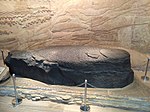
|
Chongqing | 2008 | Cultural: iii, iv | 5341 |
| Miao Nationality Villages in Southeast Guizhou Province: The villages of Miao Nationality at the Foot of Leigong Mountain in Miao Ling Mountains | 
|
Guizhou | 2008 | Cultural: i, iv, v, vi | 5344 |
| Karez Wells | 
|
Xinjiang | 2008 | Cultural: i, iv, v | 5347 |
| Expansion Project of Imperial Tombs of the Ming and Qing Dynasties: King Lujian’s Tombs (Mausoleum of the Prince Jian of Lu in Xinxiang) | 
|
Henan | 2008 | Cultural: ii, iii, iv, vi | 5351 |
| The Four Sacred Mountains as an extension of Mt. Taishan | 
|
Shanxi, Shaanxi | 2008 | Mixed: i, ii, iii, iv, vi, vii, viii | 5353 |
| Taklimakan Desert–Populus euphratica Forests | 
|
Xinjiang | 2010 | Natural: viii, ix, x | 5532 |
| China Altay | 
|
Xinjiang | 2010 | Natural: vii, viii, ix | 5533 |
| Karakorum–Pamir | 
|
Xinjiang | 2010 | Natural: viii, x | 5535 |
| Wooden Structures of Liao Dynasty – Wooden Pagoda of Yingxian County, Main Hall of Fengguo Monastery of Yixian County | 
|
Shanxi, Liaoning | 2013 | Cultural: i, iii, iv | 5803 |
| Sites of the Hongshan Culture: Niuheliang, Hongshanhou, and Weijiawopu | 
|
Liaoning, Inner Mongolia | 2013 | Cultural: i, iii, iv | 5804 |
| Ancient Porcelain Kiln Site in China (Shanglin Lake Yue Kilns and Longquan Kiln Sites at Dayao) | 
|
Zhejiang | 2013 | Cultural: ii, iii, iv | 5806 |
| Sanfang Qixiang | 
|
Fujian | 2013 | Cultural: iii, iv | 5808 |
| Western Xia Imperial Tombs | 
|
Ningxia | 2013 | Cultural: iii | 5811 |
| Dong Villages | 
|
Hunan, Guangxi | 2013 | Cultural: iii, iv, v | 5813 |
| Lingqu Canal | 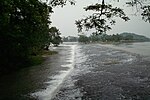
|
Guangxi | 2013 | Cultural: i, iv, vi | 5814 |
| Diaolou Buildings and Villages for Tibetan and Qiang Ethnic Groups | 
|
Suchuan | 2013 | Cultural: i, ii, iii, iv, v | 5815 |
| Archaeological Sites of the Ancient Shu State: Jinsha site and Joint Tombs of Boat-shaped Coffins in Chengdu, Sichuan; Sanxingdui site in Guanghan, 29th – 5th century BC | 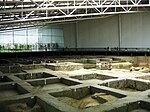
|
Sichuan | 2013 | Cultural: i, ii, iii, v | 5816 |
| Xinjiang Yardang | 
|
Xinjiang | 2015 | Natural: vii, viii | 5989 |
| Dunhuang Yardangs | 
|
Gansu | 2015 | Natural: vii, viii | 5990 |
| Tianzhushan | 
|
Anhui | 2015 | Mixed: ii, iii, v, vi, vii, viii | 5992 |
| Jinggangshan–North Wuyishan | 
|
Jiangxi, Hunan | 2015 | Mixed: iii, vi, vii, x | 5993 |
| Shudao | 
|
Sichuan | 2015 | Mixed: ii, iii, iv, vi, vii, x | 5994 |
| Tulin–Guge Scenic and Historic Interest Areas | 
|
Tibet | 2015 | Mixed: ii, iii, v, vi, vii, viii | 5995 |
| Guancen Mountain – Luya Mountain (part of the Lüliang Mountains) | 
|
Shanxi | 2017 | Natural: vii, ix | 6184 |
| Hulun Buir Landscape and Birthplace of Ancient Minority | 
|
Inner Mongolia | 2017 | Natural: iii, vii, ix, x | 6185 |
| Qinghai Lake | 
|
Qinghai | 2017 | Natural: vii, ix, x | 6186 |
| Scenic and historic area of Sacred Mountains and Lakes (Gang Rinpoche, Naimona'nyi, Lake Manasarovar and Lhanag-tso) | 
|
Tibet | 2017 | Mixed: iii, v, vi, vii, viii, x | 6187 |
| Taihang Mountain | 
|
Hebei, Shanxi, Henan | 2017 | Mixed: iii, vii, viii, x | 6188 |
| Vertical Vegetation Landscape and Volcanic Landscape in Changbai Mountain | 
|
Jillin | 2017 | Natural: vii, viii, ix, x | 6190 |
| Guizhou Triassic Fossil Sites | 
|
Guizhou | 2019 | Natural: viii | 6381 |
| Huangguoshu Scenic Area | 
|
Guizhou | 2019 | Mixed: v, vii, viii | 6380 |
| Hainan Tropical Rainforest and the Traditional Settlement of Li Ethnic Group | 
|
Hainan | 2022 | Mixed: iii, v, x | 6582 |
| Fujian Minjiang River Estuary: The ecotone between marine and terrestrial biogeographical regions | 
|
Fujian | 2022 | Natural: x | 6619 |
| Hezheng Mammalian Fossil Sites of Gansu | 
|
Gansu | 2024 | Natural: viii | 6768 |
See also
[edit]- List of UNESCO Biosphere Reserves in China
- Major Historical and Cultural Sites Protected at the National Level
- Principles for the Conservation of Heritage Sites in China
References
[edit]- ^ "The World Heritage Convention". UNESCO World Heritage Centre. Archived from the original on 27 August 2016. Retrieved 21 September 2010.
- ^ "Convention Concerning the Protection of the World Cultural and Natural Heritage". UNESCO World Heritage Centre. Archived from the original on 1 February 2021. Retrieved 3 February 2021.
- ^ a b c d "China". UNESCO World Heritage Centre. Retrieved 19 January 2025.
- ^ "World Heritage List". UNESCO World Heritage Centre. Archived from the original on 2 November 2020. Retrieved 20 December 2024.
- ^ "The Criteria for Selection". UNESCO World Heritage Centre. Archived from the original on 12 June 2016. Retrieved 17 August 2018.
- ^ "Mount Taishan". UNESCO World Heritage Centre. Retrieved 19 January 2025.
- ^ "The Great Wall". UNESCO World Heritage Centre. Retrieved 19 January 2025.
- ^ "Imperial Palaces of the Ming and Qing Dynasties in Beijing and Shenyang". UNESCO World Heritage Centre. Retrieved 19 January 2025.
- ^ "Mausoleum of the First Qin Emperor". UNESCO World Heritage Centre. Retrieved 19 January 2025.
- ^ "Mausoleum of the First Qin Emperor". UNESCO World Heritage Centre. Retrieved 19 January 2025.
- ^ "Peking Man Site at Zhoukoudian". UNESCO World Heritage Centre. Retrieved 19 January 2025.
- ^ "Mount Huangshan". UNESCO World Heritage Centre. Retrieved 19 January 2025.
- ^ "Jiuzhaigou Valley Scenic and Historic Interest Area". UNESCO World Heritage Centre. Retrieved 19 January 2025.
- ^ "Huanglong Scenic and Historic Interest Area". UNESCO World Heritage Centre. Retrieved 19 January 2025.
- ^ "Wulingyuan Scenic and Historic Interest Area". UNESCO World Heritage Centre. Retrieved 19 January 2025.
- ^ "Mountain Resort and its Outlying Temples, Chengde". UNESCO World Heritage Centre. Retrieved 19 January 2025.
- ^ "Temple and Cemetery of Confucius and the Kong Family Mansion in Qufu". UNESCO World Heritage Centre. Retrieved 19 January 2025.
- ^ "Ancient Building Complex in the Wudang Mountains". UNESCO World Heritage Centre. Retrieved 19 January 2025.
- ^ "Historic Ensemble of the Potala Palace, Lhasa". UNESCO World Heritage Centre. Retrieved 19 January 2025.
- ^ "Lushan National Park". UNESCO World Heritage Centre. Retrieved 19 January 2025.
- ^ "Mount Emei Scenic Area, including Leshan Giant Buddha Scenic Area". UNESCO World Heritage Centre. Retrieved 19 January 2025.
- ^ "Old Town of Lijiang". UNESCO World Heritage Centre. Retrieved 19 January 2025.
- ^ "Ancient City of Ping Yao". UNESCO World Heritage Centre. Retrieved 19 January 2025.
- ^ "Classical Gardens of Suzhou". UNESCO World Heritage Centre. Retrieved 19 January 2025.
- ^ "Summer Palace, an Imperial Garden in Beijing". UNESCO World Heritage Centre. Retrieved 19 January 2025.
- ^ "Temple of Heaven: an Imperial Sacrificial Altar in Beijing". UNESCO World Heritage Centre. Retrieved 19 January 2025.
- ^ "Mount Wuyi". UNESCO World Heritage Centre. Retrieved 19 January 2025.
- ^ "Dazu Rock Carvings". UNESCO World Heritage Centre. Retrieved 19 January 2025.
- ^ "Ancient Villages in Southern Anhui – Xidi and Hongcun". UNESCO World Heritage Centre. Retrieved 19 January 2025.
- ^ "Tentative Lists". UNESCO World Heritage Centre. Archived from the original on 1 April 2016. Retrieved 7 October 2010.
World Heritage Sites in China.



